

5 Healthy Habits That May Slow Aging, According to Science. 13 Tips for Aging Gracefully with Exercise, Diet, and Wellness. Use these tips to help you age gracefully from the inside out. 1.

Be kind to your skin Your skin is your body’s . If you treat it with care, it can better protect your body from the elements, regulate your body temperature, and provide sensation. To keep it looking and functioning at its best: Wear sunscreen and protective clothing when outside.Get yearly skin cancer screenings.Stick to gentle products in your anti-aging skin care routine.Stay hydrated. 2. Regular exercise significantly lowers your risk of diseases, such as heart disease and cancer, and helps you retain your mobility longer. The recommends that adults do: 2.5 to 5 hours per week of moderate-intensity exercise, 1.25 to 2.5 hours per week of vigorous-intensity aerobic exercise, or a combination of the twomuscle strengthening activities of moderate intensity or greater, that involve all major muscle groups, two or more days per week Some examples of aerobic exercise include: walkingswimmingdancingcycling 3. 4. 5. 6. 7. 8. 9. 10.
Understand the key terms in microbiome projects. Dysbiosis Sizeable changes in the composition of microorganisms in a microbiome that result in a reduction of the microbioms ability to function optimally is referred to as dysbiosis.
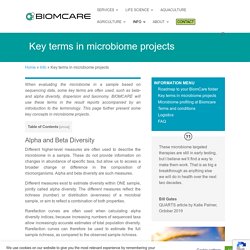
Common forms of dysbiosis in human gut samples are increased levels of Proteobacteria or reduction in diversity. However, often studies are only able to describe a changed microbiome and not to label it dysbiotic as it entails a malfunction not optimal to the host. Calorie Restriction Slows Aging of the Gut Microbiome in Mice. The gut microbiome is known to change in harmful ways with advancing age.
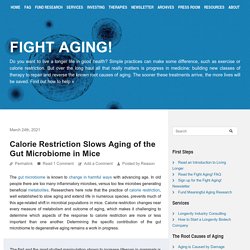
In old people there are too many inflammatory microbes, versus too few microbes generating beneficial metabolites. Researchers here note that the practice of calorie restriction, well established to slow aging and extend life in numerous species, prevents much of this age-related shift in microbial populations in mice. Calorie restriction changes near every measure of metabolism and outcome of aging, which makes it challenging to determine which aspects of the response to calorie restriction are more or less important than one another. Changing Metabolite Production in the Aging Gut Microbiome Correlates with Presence of Amyloid-β in the Brain. The research materials here examine the age-related changes in metabolite production in the gut microbiome and correlate those changes with the presence of amyloid-β in the brain, a feature of Alzheimer's disease.

It is a good companion piece to another recently published paper that links changes in microbial population abundance and Alzheimer's disease. A Look Back at 2020: Progress Towards the Treatment of Aging as a Medical Condition. While I suspect that COVID-19 will feature prominently in most retrospectives on 2020, I'll say only a little on it.

The data on mortality by year end, if taken at face value, continues to suggest that the outcome will fall at the higher end of the early estimates of a pandemic three to six times worse than a bad influenza year, ten times worse than a normal influenza year. The people who die are near entirely the old, the co-morbid, and the immunocompromised. Age-specific microbiota in altering host inflammatory and metabolic signaling as well as metabolome based on the sex - Sheng - Hepatobiliary Surgery and Nutrition. Introduction Altered gut microbial ecosystems have been associated with increased risk of metabolic and immune disorders (1,2).
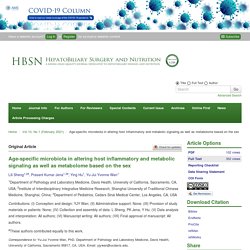
Aging is associated with chronic inflammation, a risk for age-associated pathologies such as atherosclerosis, insulin resistance, diabetes, as well as Alzheimer’s disease (3,4). Emerging evidence reveals aging-associated changes in the composition, diversity, and function of gut microbiota increases gut permeability and activates innate immune responses (5,6). Therefore, microbiome-based interventions against aging-associated health issues should provoke attention. Calling for a New Field of Gerobiotics to Reverse the Aging of the Gut Microbiome. The gut microbiome is a complex, ever-shifting collection of microbes that mediates much of the interaction between diet and health.
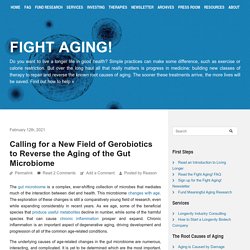
This microbiome changes with age. The exploration of these changes is still a comparatively young field of research, even while expanding considerably in recent years. As we age, some of the beneficial species that produce useful metabolites decline in number, while some of the harmful species that can cause chronic inflammation prosper and expand. Chronic inflammation is an important aspect of degenerative aging, driving development and progression of all of the common age-related conditions. How Important is the Skin Microbiome in Skin Aging?
The Gut Microbiome Becomes More Uniquely Dysfunctional with Age from Individual to Individual. The gut microbiome changes with age, and these changes are implicated in the progression of aging, such as via loss of beneficial metabolites produced by microbial species, or by chronic inflammation generated by harmful microbes when present in greater numbers.
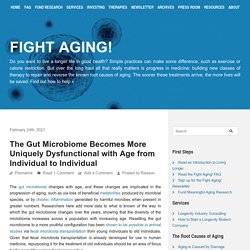
Researchers here add more data to what is known of the way in which the gut microbiome changes over the years, showing that the diversity of the microbiome increases across a population with increasing age. Resetting the gut microbiome to a more youthful configuration has been shown to be possible in animal studies via fecal microbiota transplantation from young individuals to old individuals. Given that fecal microbiota transplantation is already developed for use in human medicine, repurposing it for the treatment of old individuals should be an area of focus for the scientific and medical communities.
Data on the Effects of Fecal Microbiota Transplant Between Genders and Ages in Mice. The gut microbiome changes with age, losing populations that produce beneficial metabolites, and gaining populations that produce chronic inflammation and other harms.
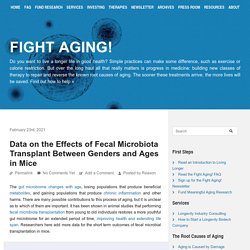
There are many possible contributions to this process of aging, but it is unclear as to which of them are important. It has been shown in animal studies that performing fecal microbiota transplantation from young to old individuals restores a more youthful gut microbiome for an extended period of time, improving health and extending life span. A Sensible Consideration of the State of the Art in the Treatment of Aging as a Medical Condition. It used to be the case that one could write up a summary of where the research community stood on the treatment of aging as a medical condition (which was varying shades of "not that far along towards practical applications, but definitely promising if they get their act together") and then not have to update it all that much for years.

Research is slow and uncertain, for one, and secondly there was, for decades, a strong cultural prejudice in the scientific community against trying to apply what was learned about aging to the treatment of aging. Little progress was made as a result. Matters are proceeding much more rapidly nowadays. Optogenetic control of gut bacterial metabolism to promote longevity. Essential revisions:1) One of the key claims made by the authors is that the optogenetic approach allows for more fine scale control of metabolite production and further that they "investigate how the lifespan extending effect of CA relates to CA levels". However, aside from one ex vivo assay (Results, Figure 2B/C), the amount of CA being secreted (or taken up by the host) is not reported. The authors claim, but don't actually show a relationship of lifespan with CA level, just green-light intensity. The relative CA production levels of the engineered strains under green light vs. the over-producing mutants should ideally be quantified and both compared to realistic exposure levels in vivo of conventionally grown C. elegans.
If this cannot be done without additional experiments, the authors should be careful to temper their claims here. We appreciate the reviewer’s comment on the comparison of CA levels among different conditions. Thank the reviewer for pointing out this concern. An emerging link between the urinary microbiome and urinary incontinence. Most people know that microorganisms live on our skin, and in other places in the body such as the digestive tract.
However, traditional thinking and medical teaching was that there was no such microbiome in the urinary tract. Many people may still believe that urine is sterile. Advanced detection methods such as enhanced urine cultures and DNA sequencing have shown that this is not true. These newer technologies have enabled identification of low levels of microorganisms that were not previously detected using conventional methods. This has revolutionized how we think about the urinary tract when it is both healthy and unwell, and has led to a paradigm shift as we recognize that the bladder, like other parts of the human body, is widely colonized by microorganisms. News Detail. Published on: 14-Nov-2019 An international research team led by Nanyang Technological University, Singapore (NTU Singapore) has found that microorganisms living in the gut may alter the ageing process, which could lead to the development of food-based treatment to slow it down.
All living organisms, including human beings, coexist with a myriad of microbial species living in and on them, and research conducted over the last 20 years has established their important role in nutrition, physiology, metabolism and behaviour. Using mice, the team led by Professor Sven Pettersson from the NTU Lee Kong Chian School of Medicine, transplanted gut microbes from old mice (24 months old) into young, germ-free mice (6 weeks old). Immunization Against Flagellin as a Way to Beneficially Alter Aging Gut Microbiota Populations. The microbial populations of the gut make a significant contribution to health via secreted metabolites and interactions with the immune system.
Starting in mid-life, these populations alter for the worse, and this is thought to influence the progression of aging - perhaps primarily as a contributing cause of chronic inflammation. How this effect size compares with those resulting from dietary and exercise choices is an open question, but it isn't unreasonable to suggest it to be in the same ballpark as exercise. What can be done to improve this situation? Supplementation with metabolites produced in larger amounts in youth, perhaps. Known options include tryptophan, indole, butyrate, and propionate, but there are no doubt many others as yet uncatalogued.
Further Evidence for Butyrate Produced by Gut Microbes to be Beneficial. A Bidirectional Relationship Between the Gut Microbiome and Aging. During the past two decades, studies have provided evidence that age-associated shifts in the gut microbiome contributes to increased predisposition of aged individuals to certain diseases, including cardiovascular diseases, cancer, obesity, cancers, diabetes, and neurodegenerative diseases. Parkinson’s Disease is Two Distinct Conditions with a Similar Outcome. Some age-related and other diseases with formal definitions based on symptoms and late stage mechanisms are likely several distinct conditions that happen to converge on a similar end result. Recent Studies on the Changing Gut Microbiome in Aging. The Aging of the Gut Microbiome in Alzheimer’s Disease.
There is No Such Thing as Aging. Gut Microbes from Younger Killifish Extend Life in Older Killifish. The research I'll point out today is interesting, but should probably be filed away for later consideration once the mechanisms involved are better understood. Tetz’s theory and law of longevity. Microbiomes other than the gut: inflammaging and age-related diseases. Tetz’s theory and law of longevity. To What Degree do Bodily Microbiomes Beyond the Gut Contribute to the Chronic Inflammation of Aging? Stem Cells, Regenerative Medicine, and Tissue Engineering. Treatments classed as regenerative medicine help our natural healing processes work more rapidly and more effectively. Predicting the Order of Arrival of the First Rejuvenation Therapies. Interventions Targeting the Aging of the Gut Microbiome.